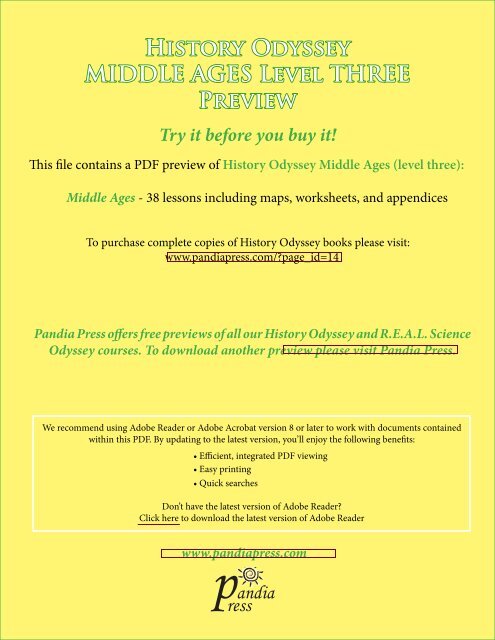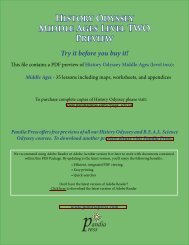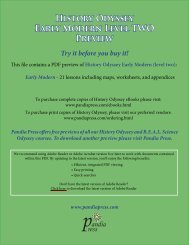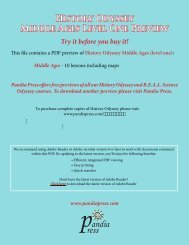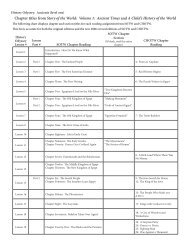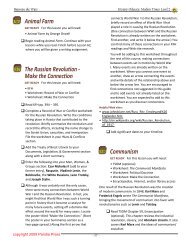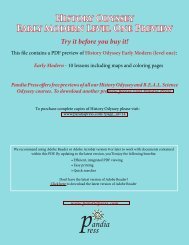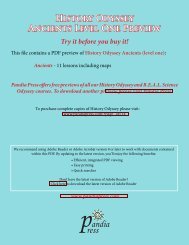History Odyssey: Middle Ages (level three) eBook ... - Pandia Press
History Odyssey: Middle Ages (level three) eBook ... - Pandia Press
History Odyssey: Middle Ages (level three) eBook ... - Pandia Press
- No tags were found...
You also want an ePaper? Increase the reach of your titles
YUMPU automatically turns print PDFs into web optimized ePapers that Google loves.
<strong>History</strong> <strong>Odyssey</strong>MIDDLE AGES Level THREEPreviewTry it before you buy it!This file contains a PDF preview of <strong>History</strong> <strong>Odyssey</strong> <strong>Middle</strong> <strong>Ages</strong> (<strong>level</strong> <strong>three</strong>):<strong>Middle</strong> <strong>Ages</strong> - 38 lessons including maps, worksheets, and appendicesTo purchase complete copies of <strong>History</strong> <strong>Odyssey</strong> books please visit:www.pandiapress.com/?page_id=14<strong>Pandia</strong> <strong>Press</strong> offers free previews of all our <strong>History</strong> <strong>Odyssey</strong> and R.E.A.L. Science<strong>Odyssey</strong> courses. To download another preview please visit <strong>Pandia</strong> <strong>Press</strong>.We recommend using Adobe Reader or Adobe Acrobat version 8 or later to work with documents containedwithin this PDF. By updating to the latest version, you’ll enjoy the following benefits:• Efficient, integrated PDF viewing• Easy printing• Quick searchesDon’t have the latest version of Adobe Reader?Click here to download the latest version of Adobe Readerwww.pandiapress.compandiaress
HISTORY ODYSSEYMIDDLE AGESPREVIEWA LITERATURE-BASEDSTUDY GUIDE COMBININGHISTORYGEOGRAPHYWRITINGWRITTEN BYKIMBERLY MAIERLEVEL THREE
<strong>History</strong> <strong>Odyssey</strong><strong>Middle</strong> <strong>Ages</strong><strong>level</strong> <strong>three</strong>Study GuidePREVIEWTo purchase a complete copy of HO <strong>Middle</strong> <strong>Ages</strong> (<strong>level</strong> <strong>three</strong>) click the link below:www.pandiapress.com/?page_id=14Kimberly Maier<strong>Pandia</strong> <strong>Press</strong>
Important information on Web links:Web site links are provided to assist students in research. At the time of printing this guide, all Web sites listedwere functional. Because Web site content changes frequently, <strong>Pandia</strong> <strong>Press</strong> cannot guarantee the availabilityof the Web links provided nor can we be responsible for Internet viruses, inappropriate, inaccurate, orobjectionable materials. We encourage parents and teachers to monitor and supervise students while on theInternet. We highly recommend the use of Internet filtering software and recommend students avoid chatrooms, downloads, and giving personal information while on the Internet.(Please email Web link problems to kathleen@pandiapress.com.)Copyright ©<strong>Pandia</strong> <strong>Press</strong>All Rights ReservedWithout limiting the rights under copyright reserved above, no part of this publication may be reproduced,stored in or introduced into a retrieval system, or transmitted, in any form, nor by any means (electronic,mechanical, photocopying, recording, or otherwise), without the prior written permission of <strong>Pandia</strong> <strong>Press</strong>. Thepurchaser of this study guide may photocopy maps and worksheets for use with his or her children. Copyingfor group, co-op, classroom, or school use is prohibited. Contact <strong>Pandia</strong> <strong>Press</strong> for information about orderingextra worksheets, and maps, and about school licensing.Published by<strong>Pandia</strong> <strong>Press</strong>Mount Dora, FLVisit www.pandiapress.com for sample pages of <strong>Pandia</strong> <strong>Press</strong> publications and for ordering information.
Dear Parent, Teacher, and Student:We welcome you to <strong>History</strong> <strong>Odyssey</strong>: <strong>Middle</strong> <strong>Ages</strong> (<strong>level</strong> <strong>three</strong>). Level <strong>three</strong> <strong>History</strong> <strong>Odyssey</strong> guides are written for 9 ththrough 12 th grade students engaged in the rhetoric stage of a classical education. The guides are structured aroundThe New <strong>History</strong> of the World written by J.M. Roberts and are enhanced by copious reading of source documentsand classic literary works for each time period. Understanding and mastery of concepts are accomplished bycomplementing the reading assignments with a wide variety of writing projects including expository, descriptive,narrative, and persuasive essays. Using a wide range of media for research purposes, students will learn howto develop concise thesis statements and well-written research papers. The <strong>History</strong> <strong>Odyssey</strong> guides emphasizesynthesis of knowledge by combining the disciplines of history, literature, writing, and geography.It is a daunting task to undertake the study of history beginning with the known origins of human civilization.We have chosen a balance of a broad, general overview combined with topics of intense scrutiny to help bring tolife the rich history of humankind. It is important to note that this is a study guide that will encourage studentsto follow the path of civilization, perhaps taking many detours along the way. In most cases, two or more writingassignment options are given for each topic to allow freedom of choice. It may be that some students will wishto explore other topics of more importance or interest to them for a particular segment of history than those wehave listed—by all means, feel free to do so.The lessons in this guide are not necessarily intended to be completed in one class session. Lessons containinglengthy reading and/or writing assignments will certainly require more than one class session. Students areencouraged to proceed at their own pace, but in accordance with time requirements placed on them by parentsor teachers. Remember, these lesson plans combine several subjects—history, literature, writing, and geography.For this age group we recommend a study schedule of two to <strong>three</strong> hours per day, four to five days per week. Thisguide will comprise a one-year history course for most students studying at this pace.5
IntroductionRequired ResourcesThe following resources are needed to complete this course. Additional resources and book recommendationscan be found in Appendix G.☐ * The New <strong>History</strong> of the World by J.M. Roberts☐ * The World’s Great Speeches edited by Copeland, Lamm, & McKenna☐ *Timeline (from <strong>Pandia</strong> <strong>Press</strong> or homemade)☐ Beowulf translated by Howell D. Chickering, Jr.☐ The Song of Roland translated by Dorothy L. Sayers☐ The Travels by Marco Polo, translated by Ronald Latham☐ 1066: The Year of the Conquest by David Howarth☐ Life in a Medieval City by Joseph and Frances Gies☐ Sir Gawain and the Green Knight, Patience, and Pearl verse translations by Marie Borroff☐ The Inferno by Dante Alighieri, translated by John Ciardi☐ The Canterbury Tales by Geoffrey Chaucer, prose translation by R.M. Lumiansky☐ The Prince by Niccolo Machiavelli, translated by George Bull☐ Hamlet by William Shakespeare, CliffsComplete version edited by Terri Mategrano☐ Essays by Michel de Montaigne, translated by J. M. Cohen☐Recommended map resource: World <strong>History</strong> Atlas from Maps.com* These resources will be used over several years in all Level Three <strong>History</strong> <strong>Odyssey</strong> study guides.Other Supplies NeededIn addition to the books and resources listed above, you will need the following:☐☐☐☐☐☐☐☐☐☐Three-ring binderEight tab dividersPaper (either lined notebook paper or computer printer paper)Colored pencils and a fine tipped marker for map workThree-hole punchWrite-on transparency film or printer/copier transparency film (optional)Transparency markers (optional)Miscellaneous arts and crafts suppliesInternet access for map workDetailed atlas of the world7
Setting Up Your BinderAs you progress through this study guide, you will build your own record and commentary of world historythat will be filed in a <strong>three</strong>-ring binder.Divide your binder into the following sections:Outlines & SummariesMen & WomenGovernment & WarReligion & PhilosophyArt & LiteratureInventions & AchievementsMaps & WorksheetsTimelinePlace this study guide in the front of your binder. Place the maps, worksheets, and your timeline in the appropriatesections. Place lined paper in the remaining sections or add computer printouts as you create them.Lesson AssignmentsThroughout these lessons you will be asked to synthesize your readings through outlining, writing assignments,projects, entering dates on your timeline, and map work.Writing AssignmentsYou will be asked to write short descriptions or summaries of key concepts and events (e.g., of a specificperson, work of art, or invention) which should be written as a concise paragraph consisting of 100 to 150 words.At times you will be instructed to write a one-page description or biography, which should consist of about 250words.You will also be asked to outline chapters in The New <strong>History</strong> of the World (your main history reference spine).We recommend that you seek an outlining instruction course if you have not had experience in outlining. Inlieu of outlining, you may choose to summarize in paragraph form or list key ideas. However, we recommendyou outline at least a few chapters.Additionally, you will be assigned research and expository compositions. These papers should consist ofbetween 500 to 1,000 words (approximately two to four double-spaced, typed pages). When you are asked toresearch a topic, you may use any means available for your investigation, including, but not limited to, the libraryand the internet. Where appropriate, suggestions for specific resources will be listed in the appendices.A lesson on writing thesis statements can be found in Appendix A. This lesson is from Ancients (<strong>level</strong> <strong>three</strong>).If you did not complete the Ancients course or if you need practice in thesis writing, it is recommended that youreview this lesson prior to beginning this course.NOTE TO PARENTS AND TEACHERS: Please note that this <strong>History</strong> <strong>Odyssey</strong> course is not intended to replaceinstruction in high school and early college-<strong>level</strong> writing. However, this is without a doubt a writing-intensivehistory course. What you see reflected in our suggestions for assignments may be uncomfortably difficult for astudent without a strong writing background. Please don’t be intimidated. Above all, don’t allow your studentto give up! We recommend that you help your student gain mastery of the writing process by working througha formal writing course intended for high school or college writing.8
If you do not already have a process in place for teaching your student essay writing, we recommend thefollowing writing programs:Brave Writer “Help for High School” e-book www.bravewriter.com/Welcome/hhsdescrip.htmlTeaching Writing Structure and Style by The Institute for Excellence in Writing www.writing-edu.comWriting Strands www.writingstrands.comTeaching the Essay and Teaching the Research Paper by Robin Finley www.analyticalgrammar.comOther writing resources can be found online by doing a search with the words “high school writing” and“thesis statement history” and following the links offered. Pay particular attention to thesis statements, developingarguments, and typical essay forms. Review formats for attribution of quotes and have students take great carein citing sources to avoid plagiarism in their academic writing.You will find an Essay Grading Rubric in Appendix H. Copy and use this page for evaluating or grading theessay writing assignments.TimelinesChoose a timeline format that suits your needs. Timelines can be notated in many different ways includingwriting dates and descriptions only, drawing illustrations to accompany your dates and descriptions, or purchasingtimeline software. Periodically throughout this course, you will be revisiting dates on your timeline to addinformation about additional cultures and events.Alternatively, you may opt to omit a timeline from your rhetoric stage study. This may be appropriate if youhave a solid foundation in timeline construction and analysis. We strongly recommend you keep a timeline ifyou have no prior experience with this tool.The Timeline Analysis assignment in Part XV is recommended for all students.Map WorkGeography is a key element in the study of history. We recommend you color your maps using good qualitycolored pencils and label them with a fine-point pen.When you have completed each map as assigned, we suggest you create a transparency overlay for that mapon which you will label modern-day countries and cities. This will give you a firm understanding of the changesthat have occurred over time and of the historical areas of the world as they correspond to today’s regions. Youcan accomplish this by using write-on transparency film (available at office supply stores) and markers designedfor transparency use. Just trace the outlines from your completed map and fill in the current information usinga world atlas, wall map, or globe. Another option is to use printer/copier transparency film and copy each maponto the transparency before completing the assignment. Then you can fill in the modern information on thecopied transparency. As a final option, you may write the modern-day labels in parentheses on each map.We have included a few Web addresses, especially for map resources, in this guide. In the event that youdo not have Internet access, you should be able to locate your resources at a library. Many of the map workassignments can be completed using the historic maps found in World <strong>History</strong> Atlas from Maps.com. You willfind many Web links to Maps.com in this guide. Alternatively, you might consider purchasing the print editionof World <strong>History</strong> Atlas.9
WorksheetsPlease be certain to make sufficient photocopies of all worksheets before marking your original copy. Wehave placed reminders to photocopy extra sheets within the course as the worksheets are required.SchedulingWe suggest a study schedule of two to <strong>three</strong> hours per day, four to five days per week. This will insure thatyou allow adequate time for reading, research, writing, editing, re-writing, and project completion.How to Read a BookIf you did not complete Ancients (<strong>level</strong> <strong>three</strong>), we recommend you read How to Read a Book by MortimerAdler and Charles Van Doren. This “classic guide to intelligent reading” will not only equip you for the successfulcompletion of this <strong>Middle</strong> <strong>Ages</strong> course, but will also prepare you for higher-<strong>level</strong> reading comprehension for therest of your life.10
<strong>Middle</strong> <strong>Ages</strong> (<strong>level</strong> <strong>three</strong>) Course OutlineI. The Elements of a FutureA. Who’s Who DirectoryB. Map - Germanic MigrationsC. “The Reign of Justinian” Research and Writing AssignmentD. “Monasticism” Research and Writing AssignmentE. Map - Europe and the Byzantine EmpireF. “Germanic Tribes Summary” AssignmentG. Beowulf and Writing AssignmentH. Map - Viking ExpansionII. Islam and the Remaking of the Near EastA. Who’s Who DirectoryB. Map - The Spread of IslamIII. The Arab EmpiresA. Who’s Who DirectoryB. “Overview of the Spread of Islam” Chart SetC. “Sunni and Shi’ite” Research and ExpositionIV. Byzantium and Its SphereA. Who’s Who DirectoryB. Map - Kiev RusV. The Disputed Legacies of the Near EastA. Who’s Who DirectoryB. Map - Seljuk EmpireC. Map - Ottoman Expansion and the Safavid EmpireD. “Islamic Empires” Research and Writing AssignmentVI. The Making of EuropeA. Who’s Who DirectoryB. Map - The Empire of CharlemagneC. “Carolingian Renaissance Pamphlet” ProjectD. The Song of Roland Synopses and EssayVII. IndiaA. Who’s Who DirectoryB. Map - The Mogul EmpireC. “Indian Empires Survey” Chart SetVIII. Imperial ChinaA. Who’s Who DirectoryB. Map - T’ang DynastyC. “Ch’an Buddhism” ExpositionD. Map - Song Dynasty11
12E. “Monumental Landscape Painting” Oral PresentationF. Map - Ming DynastyG. “Zheng He” Letter Writing AssignmentH. Map - Mongol EmpiresI. The Travels and “Travel Diary and Scrapbook” ProjectIX. JapanA. Who’s Who DirectoryB. Map - Feudal Provinces of JapanC. “Japanese Historical Era Travel Brochure” ProjectX. Worlds ApartA. Who’s Who DirectoryB. Map - African KingdomsC. Map - Central and South AmericaD. “Maya, Aztec, or Inca Lesson Plan” ProjectXI. Europe: The First RevolutionA. Who’s Who DirectoryB. 1066: The Year of ConquestC. “Claimants to the Throne of England” ChartD. Map - The Norman ConquestE. “Norman Conquest Historical Account” ProjectF. Map - Medieval Europe and the Holy Roman EmpireG. “Holy Roman Empire Annotated Timeline”H. Life in a Medieval City and “Ethnographic Field Collection” ProjectXII. New Limits, New HorizonsA. Who’s Who DirectoryB. Map - The Early CrusadesC. “A Second Crusade” Selected ReadingD. “Early Crusades: Causes and Consequences” Research and Writing AssignmentE. Sir Gawain and the Green Knight and “Character Analysis” ProjectF. The Inferno and “Traveler’s Guide to the Underworld” Project and Essay AssignmentG. Map - Spread of the Black Death and Medieval Trade RoutesH. Map - The Hundred Years’ WarI. “<strong>Middle</strong> <strong>Ages</strong> Newspaper” ProjectJ. The Canterbury Tales and Essay AssignmentXIII. A New Kind of Society: Early Modern EuropeA. Who’s Who DirectoryB. Map - The Rise of Moscow and Russian ExpansionC. Map - European ExplorationD. “European Exploration Issues” Essay AssignmentE. “Phenomenon of the Italian Renaissance” Essay AssignmentF. Map - Renaissance ItalyG. “Renaissance Man Biography” Writing Assignment
H. The Prince and “Synopsis Chart” and Writing AssignmentXIV. Authority and Its ChallengersA. Who’s Who DirectoryB. Map - EuropeC. Map - Reformation and Counter-Reformation EuropeD. “Before the Diet of Worms” and “On Suffering and Persecution” Selected ReadingsE. “Reformation and Counter-Reformation Compendium” Writing AssignmentF. “Reformation and Counter-Reformation Issues” Writing AssignmentG. Hamlet and “Elements Identification Chart” and Writing Assignment or ProjectH. “Elizabethan Era” ProjectI. Essays and “Personal Essay” AssignmentXV. Final ProjectNote: The Roman numeral lesson titles noted above are taken from corresponding chapters in the text TheNew <strong>History</strong> of the World by J.M. Roberts.13
Part IThe Elements of a Future“In other living creatures the ignorance of themselves is nature, but in men it is a vice.”Boethius
Who’s WhoWho’s Who in the <strong>Middle</strong> <strong>Ages</strong> and Early Renaissance Project: The world is busier and more populated asyou begin your study of the medieval and early Renaissance periods of history. In order to learn about a vastnumber of influential and important people from this historical period, you will have an ongoing project forthis <strong>History</strong> <strong>Odyssey</strong> course.You will be compiling a Who’s Who style directory of assigned individuals. Locate the “Who’s Who in the<strong>Middle</strong> <strong>Ages</strong> and Early Renaissance” (Who’s Who) directory example in Appendix B. Follow this formatfor each assigned entry and place in the Men & Women section of your binder. Individuals for whom youcannot locate specific information on education or career may be summarized according to their works,achievements, and importance in history under the “Special Attributes” heading.The suggested individuals are by no means exhaustive—there are too many people to list or study in a oneyearhistory course. Feel free to add people not specifically assigned in this study guide should you wish toinclude them for your own reference.Lesson 1☐Read The New <strong>History</strong> of the World (NHW) pp. 301 - 314, “The Elements of a Future.”Today you will begin reading The New <strong>History</strong> of the World by J.M. Roberts. For the purposes of this course,you will begin your reading at Book Three, Chapter Nine, “The Elements of a Future.” This book is thefoundation of your <strong>Middle</strong> <strong>Ages</strong> and Early Renaissance course. If you used <strong>History</strong> <strong>Odyssey</strong>, Ancients (<strong>level</strong><strong>three</strong>), you will be familiar with NHW. Consider this text as a springboard to further research and inquiry.You will be asked to outline or summarize* the reading material and place it in the Outlines & Summariessection of your binder. This section will become your personal record and commentary on world historyevents. (A sample outline of Book Two, Chapter Two from NHW, “Ancient Mesopotamia,” can be found inAppendix C of this study guide.)*You may choose either to outline or summarize the chapters in NHW. If summarizing, you can list key ideasor summarize in paragraph form. Outlining is an important skill to practice; therefore, we recommend yououtline some of the chapters.☐ Outline or summarize these pages; insert your work into your binder in the Outlines & Summariessection.Lesson 2☐Add these people to your Who’s Who directory:Attila the HunSaint BenedictBoethiusClovisGregory the GreatLeo the GreatOdoacerTheodoricJustinian17
☐ Map 1—Germanic Migrations, 5th Century. Refer to the map on page 295 in NHW, the map on page 13in World <strong>History</strong> Atlas, the map at www.worldmapsonline.com/UnivHist/Univ-World-<strong>History</strong>-Maps.htm,and/or other map sources.Delineate and color the land area of the Western Roman Empire and the Byzantine Empire circa 400 AD.Draw lines of migration for the following tribes:Franks (350 - 455) Saxons (450) Angles (455)Visigoths (378 - 418) Jutes (450) Lombards (455)Vandals (406 - 455) Ostrogoths (451 - 489)Burgundians (443 - 534) Huns (451 - 551)Label as many cities, regions, and countries as possible. Label major landforms such as mountains, deserts,and plateaus. Label all bodies of water. Place your completed map in the Maps section of your binder.☐Enter significant dates on your timeline from Lesson 1. See Appendix D for suggested dates.Lesson 3☐ Justinian has been named the last Roman and the first Byzantine emperor. His reign was significant as aturning point between the old and new regimes. Conduct some outside research on the reign of Justinian andchoose one of the following writing assignments:(1) Describe the Code of Justinian, its differences from prior centuries of Roman law, and its legacy inmodern times; or(2) Roberts states, “In retrospect, Justinian seems something of a failure.” Support or refute thisstatement.Note: You might want to review “How to Write a Thesis Statement” found in Appendix A in preparation forthis writing assignment.Lesson 4☐ Roberts saw the burgeoning institution of monasticism as a “lifeline in the dangerous rapids between acivilization which had collapsed and one yet to be born.” Research the emergence of monasticism. Explainwhy it developed, what purpose it served, how it changed, and who its major contributors were. Include briefsummaries of the well-known orders: Benedictines, Cistercians, Franciscans, Cluniacs, and Dominicans.Conclude your essay by answering this question: What purpose does monasticism serve today? Place youressay in the Religion & Philosophy section of your binder.Alternatively, you may complete this assignment as an oral presentation. You should prepare some visualaids to accompany your presentation. Your visual aids may be handmade or created by using software suchas Microsoft’s PowerPoint. After you have given your presentation to an audience, place your work in theReligion & Philosophy section of your binder.18
Lesson 5☐Map 2—Europe and the Byzantine Empire, 6 th CenturyRefer to the map on page 310 in NHW, the map on page 14 in World <strong>History</strong> Atlas, the map atwww.worldmapsonline.com/UnivHist/Univ-World-<strong>History</strong>-Maps.htm, and/or other map sources.Delineate and color the land areas of the Byzantine empire before Justinian’s reign and the subsequent areasof Justinian’s conquest.Delineate and color the land areas for the following kingdoms and tribal territories:Kingdom of the Burgundians Kingdom of the VandalsKingdom of the FranksKingdom of the VisigothsKingdom of the OstrogothsTerritories:Alemanni Danes SaxonsAngles Gepids ScotsBasques Jutes SlavsBerbers Lombards SueviCelts Picts ThuringiansLabel as many cities, regions, and countries as possible. Label major landforms such as mountains, deserts,and plateaus. Label all bodies of water. Place your completed map in the Maps section of your binder.Lesson 6☐ Research and write a brief summary of each of the following six Germanic tribes which migrated into,and had an impact on, the Western Roman Empire in the 5 th and 6 th centuries:Burgundians Lombards VandalsFranks Ostrogoths VisigothsInclude their dates of supremacy, notable rulers, participation in the decline and collapse of the RomanEmpire, key features, and final disposition. Place your summaries in the Government & War section of yourbinder. The following Web site may be helpful in your research: www.friesian.com/germania.htm.Lesson 7☐Read Beowulf pp. 1 - 28, Introduction.Today you will begin reading Beowulf, translated by Howell D. Chickering, Jr. It is the first great heroic, andlongest surviving, Old English poem. Beowulf is a literary epic which recounts the deeds and adventures ofa sixth-century hero, and which reflects the values of the Anglo-Saxon society in which it was authored. Itis believed the poem originated with the Scandinavian Geats and was transported during the migrations.19
Scholars have concluded that King Hrothgar and the Scyldings are based on actual people living inScandinavia in the 6 th century. Begun in the oral tradition, the story was eventually committed to manuscript.The exact dates of the original oral version and the first written manuscript are unknown, but scholarsgenerally agree that the story was authored sometime between 675 AD and 1000 AD.Lesson 8☐Read Beowulf pp. 245 - 277, Backgrounds.Lesson 9☐Map 3—Viking Expansion, 8 th to 11 th CenturiesRefer to the maps at en.wikipedia.org/wiki/Image:Viking_expansion.png,www.nmm.ac.uk/upload/pdf/Viking_routes.pdf, and/or other map sources.Delineate and color the land areas of:8 th Century Viking settlement9 th Century Viking settlement10 th Century Viking settlement11 th Century Viking settlementAreas subject to Viking raids but little or no settlementDraw lines with arrows indicating the Viking trade, settlement, and attack routes. Differentiate between sea,overland, and river routes.Label as many cities, regions, and countries as possible. Label major landforms such as mountains, deserts,and plateaus. Label all bodies of water. Place your completed map in the Maps section of your binder.Lesson 10☐ Read Beowulf pp. 49 - 113.☐ Literary epics contain several characteristic features. As you read Beowulf, complete the “Elements of EpicLiterature” chart (located in the Worksheets section of your binder). Make sure your examples are written ascomplete paragraphs, including a strong topic sentence. If you studied <strong>History</strong> <strong>Odyssey</strong>, <strong>Middle</strong> <strong>Ages</strong> (<strong>level</strong>two), you will have completed a similar chart. Your Level Three chart should be much more detailed.20
Lesson 11☐ Read Beowulf pp. 115 - 179.Lesson 12☐ Read Beowulf pp. 181 - 243.Lesson 13☐Now that you have finished reading Beowulf, choose one of the following writing topics:(1) Explore the concepts of predestination and free will as they apply to Beowulf in the undertaking of hisquest. Include specific examples from the poem to support your analysis.(2) Choose a modern-day story (it may be literature, television, or film) that might be classified as anepic. Prove that your selection is an epic by identifying the characteristics in that story as listed on the“Elements of Epic Literature” chart. Use specific and detailed examples from your selection to supportyour position.(3) Scholars have asked the question, “Is Beowulf an ideal king or is he flawed by his heroic quest forfame?” Respond in depth to this issue.(4) Identify both the Christian and pagan influences in Beowulf and analyze the relationship between thetwo.Place your essay in the Art & Literature section of your binder.21
Part IIIslam and the Remaking of the Near East“Knowledge is the eye of desire and can become the pilot of the soul.”Will Durant
Lesson 14☐ Read NHW pp. 315 - 316, “The Age of Diverging Traditions,” “Introduction,” and pp. 317 - 332, “Islamand the Remaking of the Near East.”☐ Outline or summarize these pages; insert your work into your binder in the Outlines & Summariessection.Lesson 15☐Add these people to your Who’s Who directory:Abu-BakrChosroes IChosroes IIMuhammad☐Map 4—The Spread of Islam, 7 th and 8 th CenturiesRefer to the map on page 329 in NHW, the map on page 16 in World <strong>History</strong> Atlas, the map atwww.worldmapsonline.com/UnivHist/Univ-World-<strong>History</strong>-Maps.htm, and/or other map sources.Delineate and color the land areas of:Islamic territory under Muhammad, 622 - 632Expansion under the first four Caliphs, 632 - 661Expansion under the Umayyad Caliphs, 661 - 750Draw lines with arrows indicating the military routes of conquest.Label as many cities, regions, and countries as possible. Label major landforms such as mountains, deserts,and plateaus. Label all bodies of water. Place your completed map in the Maps section of your binder.☐Enter significant dates on your timeline from Lesson 14. See Appendix D for suggested dates.25
Part IIIThe Arab Empires“The knowledge of anything, since all things have causes, is not acquired or complete unless it is known by its causes.”Ibn Sina (Avicenna)
Lesson 16☐Read NHW pp. 333 - 344, “The Arab Empires.”☐ Outline or summarize these pages; insert your work into your binder in the Outlines & Summariessection.Lesson 17☐Add these people to your Who’s Who directory:Abu-al-AbbasAl-KhwarizmiAl-KindiHaroun-al-RashidIbn BattutaIbn-Sina (Avicenna)Mu-Awiya☐Enter significant dates on your timeline from Lesson 16. See Appendix D for suggested dates.Lesson 18☐ Research and complete the chart set titled “Overviews of The Spread of Islam” for Asia, Africa, Arabia,and Europe located in your Worksheet section. You may wish to refer to “The Spread of Islam” mapcompleted in Lesson 15. Place the charts in the Government & War section of your binder.Lesson 19☐ Write a brief exposition addressing the similarities and the differences between the Sunni and Shi’itebranches of Islam. Identify the cause of the original schism between the two, and analyze the current conflict.The following Web site may be helpful in your research: hnn.us/articles/934.html.29
Part IVByzantium and Its Sphere“The purpose of learning is growth, and our minds, unlike our bodies, can continue growing as long as we live.”Mortimer Adler
Lesson 20☐Read NHW pp. 345 - 371, “Byzantium and Its Sphere.”☐ Outline or summarize these pages; insert your work into your binder in the Outlines & Summariessection.Lesson 21☐Add these people to your Who’s Who directory:Prince ArpadConstans IICuthredSt. CyrilHeracliusLeo IIIMiesko IDuke MoymirOffa of MerciaSaint MethodiusDuke WenceslasLesson 22☐Map 5—Kiev Rus, 11 th CenturyRefer to the map on page 363 in NHW and/or other map sources.Delineate and color the land areas of Kiev in the 11 th century.Label as many cities, regions, and countries as possible. Label major landforms such as mountains, deserts,and plateaus. Label all bodies of water. Place your completed map in the Maps section of your binder.☐Enter significant dates on your timeline from Lessons 20 and 21. See Appendix D for suggested dates.33
Part VThe Disputed Legacies of the Near East“Be happy for this moment. This moment is your life.”Omar Khayyam
Lesson 23☐Read NHW pp. 372 - 392, “The Disputed Legacies of the Near East.”☐ Outline or summarize these pages; insert your work into your binder in the Outlines & Summariessection.Lesson 24☐Add these people to your Who’s Who directory:Abbas the GreatChinghis KhanJelaleddin RumiKubilai KhanMalik ShahOmar KhayyamOsmanMehmet IISaladinSuleyman the MagnificentTimur Lang (Tamerlane)Omar Khayyam, although not only an accomplished poet, is best known for his collection of poetry, theRubaiyat of Omar Khayyam. There are many library and online resources containing translations of thiswork, should you wish to read it.Note that you will be studying the Mongol Empire, along with Kubilai Khan, in greater detail later in thiscourse.Lesson 25☐Map 6—Seljuk Empire, 11 th CenturyRefer to the map on page 134 in The Kingfisher <strong>History</strong> Encyclopedia, aten.wikipedia.org/wiki/Image:Seldschuken-Reich-map.png, and/or other map sources.Delineate and color the land areas of the Seljuk Empire during its height in the 11 th century.Draw lines with arrows indicating the routes of expansion and conquest.Label as many cities, regions, and countries as possible. Label major landforms such as mountains, deserts,and plateaus. Label all bodies of water. Place your completed map in the Maps section of your binder.37
☐Map 7—Ottoman Expansion, 12 th to 16 th Centuries and The Safavid Empire, 16 th CenturyRefer to the map on page 389 in NHW, the map on page 25 in World <strong>History</strong> Atlas, the maps atnewton.uor.edu/FacultyFolder/rebecca_brown/old/arth100/empire/safavids/safmapB.htm, and/or othermap sources.Delineate and color the land areas of:Ottoman Empire 1326Ottoman Empire 1451Ottoman Empire 1520Safavid Persian Empire 16th CenturyLabel as many cities, regions, and countries as possible. Label major landforms such as mountains, deserts,and plateaus. Label all bodies of water. Place your completed map in the Maps section of your binder.☐Enter significant dates on your timeline from Lessons 23 and 24. See Appendix D for suggested dates.Lesson 26☐Research the four following empires:Abbasid Dynasty Safavid Empire Seljuk Empire Ottoman EmpireChoose one of the empires to explore in detail and write a two- to <strong>three</strong>-page report. Be sure to address therise and fall of the empire, expansion and conquest, culture and religion, government, influence and effect onthe world at its time, and its legacy. Write a brief summary of each of the other <strong>three</strong> empires. Place your workin the Government & War section of your binder.38
Part VIThe Making of Europe“To have another language is to possess a second soul.”Charlemagne
Lesson 27☐Read NHW pp. 393 - 421, “The Making of Europe.”☐ Outline or summarize these pages; insert your work into your binder in the Outlines & Summariessection.Lesson 28☐Choose at least ten of these people to add to your Who’s Who directory:AlcuinAlfred the GreatAthelbaldAthelredBarbarossaBrian BoruSaint BonifaceCanuteHugh CapetCharlemagneCharles IIICharles MartelConrad of FranconiaHenry the FowlerHarald HardradaLeo IIILouis the PiousNicholas IOtto the GreatPepin of HerstalPepin the ShortRolloLesson 29☐Map 8—The Empire of Charlemagne, 8 th CenturyRefer to the map found on page 396 in NHW, and/or other map sources.Delineate and color the land areas of the Carolingian Empire:Frankish tributaries circa 800 ADFrankish kingdoms at 768 ADAreas conquered by CharlemagneLabel as many cities, regions, and countries as possible. Label major landforms such as mountains, deserts,and plateaus. Label all bodies of water. Place your completed map in the Maps section of your binder.☐Enter significant dates on your timeline from Lessons 27 and 28. See Appendix D for suggested dates.41
Lesson 30☐ The Carolingian Renaissance—This is the name modern scholars have bestowed upon the reign ofCharlemagne. Create a pamphlet describing the characteristics of the Carolingian era and the legacy ofCharlemagne, and explaining how it can be called a renaissance. Include illustrations indicative of thecontent, i.e., a portrait of Charlemagne, art and architecture, manuscripts, etc. Place your pamphlet in theInventions & Achievements section of your binder.Lesson 31☐Read The Song of Roland (Roland), pp. 7 - 44, Introduction.Today you will begin reading The Song of Roland, translated by Dorothy Sayers. Chansons de geste, or “songsof great deeds,” were the French counterpart to the Anglo-Saxon epic poems and were particularly popularin the 11 th and 12 th centuries. Sung or chanted, these poems were divided into laisses (stanzas) of irregularlength. The Song of Roland was first written down sometime in the 11 th century; and while its setting is inthe 8 th century, it reflects the chivalric, military, and religious values of the later period. It is the epic storyof Charlemagne and his nephew, Roland, and their roles in the great and ongoing battle of Cross versusCrescent.Lesson 32☐ Read Roland, Laisses 1 - 49.☐ As you read this poem, write a brief synopsis (two to four sentences) of each stanza. For example, yoursynopsis of Laisse 2 might read:King Marsilion is in despair over Charlemagne’s repeated victorious invasions into Saracen territory.He summons his men to ask their advice on the problem, and one lord, Blancandrin, replies.Should you require help with your synopses, we recommend you reference this Web site:www.yorku.ca/inpar . Select “Old French Series” from the left column and then select “The Song of Roland”from the list. Try to write your synopses on your own, referencing this Web site only if you have difficulty.Lesson 33☐ Read Roland, Laisses 50 - 97.☐Write a brief synopsis (two to four sentences) of each stanza.42
Lesson 34☐ Read Roland, Laisses 98 - 146.☐Write a brief synopsis (two to four sentences) of each stanza.Lesson 35☐ Read Roland, Laisses 147 - 189.☐Write a brief synopsis (two to four sentences) of each stanza.Lesson 36☐ Read Roland, Laisses 190 - 237.☐Write a brief synopsis (two to four sentences) of each stanza.Lesson 37☐ Read Roland, Laisses 238 - 291.☐ Write a brief synopsis (two to four sentences) of each stanza. Place your completed synopses of The Songof Roland in the Art & Literature section of your binder. You may wish to refer to them when writing youressay for the next lesson.Lesson 38☐Choose one of the following writing assignments for The Song of Roland:(1) The Song of Roland carries a theme of Christian good versus Saracen (Islamic) evil. Analyze theportrayals of both the Christians and the Saracens as they pertain to and illustrate this theme. Usespecific examples from the poem.(2) Compare and contrast the major events as they occur in the poem with historical fact (you will needto do some outside research for this topic).(3) Do you think The Song of Roland could be made into a successful movie for today’s audience? Be sureto consider the issues of religion and culture as you support your thesis.Place your essay in the Art & Literature section of your binder.43
Thank you for previewing <strong>History</strong> <strong>Odyssey</strong> - <strong>Middle</strong> <strong>Ages</strong> (<strong>level</strong> <strong>three</strong>). We hopeyou have enjoyed the course so far! To continue the course, please purchase the courseat www.pandiapress.com/?page_id=14
Appendix AHow to Write a Thesis StatementWhat is a Thesis Statement?In order to have a well-written essay, you must first have a concise and well-written thesis statement. The thesisstatement is essentially the topic sentence or central idea for your essay. It is not a statement of fact about a subject,but rather it is a declaration of your position on an issue. It is the argument you intend to explain or defend in yourwriting. Such an argument may result from your conclusion or opinion about a topic, or it may be in response toan assigned essay question. In your thesis statement you will be explaining to the reader the main point of youressay. The paragraphs that follow will prove and support that main point.The anatomy of a good essay is comparable to the anatomy of a good paragraph:EssayThesis StatementSupporting ParagraphsParagraphTopic SentenceSupporting SentencesWhat is the Purpose of a Thesis Statement?Your thesis statement serves two important purposes:(1) it is your guideline for researching and writing your essay, and(2) it is your reader’s guideline for understanding your essay.You can see how critical the thesis statement is to developing a strong and coherent essay.How Do You Develop a Thesis Statement?• First you must choose a topic. This may be a topic that interests you personally or it may be a topic that hasbeen assigned to you.Examples:Ancient Sumerian ReligionPeloponnesian War• Next you will narrow your topic. The topics listed above are too broad and general to be addressed in an essay;indeed, many lengthy books have already been written on both subjects. Choose one aspect of your general topicthat may be adequately covered in a high school or college-<strong>level</strong> composition, i.e., anywhere from <strong>three</strong> to tenpages in length.Examples:Ancient Sumerian Religion in Everyday LifeCauses of the Peloponnesian WarAt this point, you may need to begin researching your topic if you have no prior knowledge of the subject. Yourresearch may reveal patterns, controversies, or idiosyncrasies that you can investigate or you may find a particulararea of the topic which is especially interesting to you. From this information, you can craft a thesis statement.105
• Now it is time to ask a question about your narrowed topic. The answer to this question will become yourthesis statement.Examples:What influence, if any, did religion in Ancient Sumer haveon the everyday lives of the people?Did the growth and rise to power of Athens contribute to thecommencement of the Peloponnesian War?• Answer your question as concisely as possible and you will have a thesis statement.Examples:The religious belief system was the major driving force forall other aspects of life in Ancient Sumer, including politics,architecture, and education.The displacement of Sparta by Athens as the leading powerin Ancient Greece and the ensuing fear of Athens by Spartawere decisive factors in the commencement of thePeloponnesian War.Where Should You Place the Thesis Statement?Your thesis statement may be either the first or last sentence in your introductory paragraph.What If the Thesis Statement Changes?Your thesis statement may change as you research your topic. This is an acceptable part of the writing process. Justmake sure the final thesis is proved and supported by the body of the essay.106
Appendix BWho’s Who in the <strong>Middle</strong> <strong>Ages</strong> and RenaissanceSample PageMichel Eyguem de MontaigneArea of Influence: Philosopher, Renaissance author, originator of the essay as a literary genreBorn: Chateau de Montaigne, Bordeaux, France, February 28, 1533Died: Chateau de Montaigne, Bordeaux, France, September 13, 1592_________________________________________________________________EducationCollege de Guyenne, BordeauxStudied law in Bordeaux and ToulouseCareerCounselor, Court des Aides of PerigueauxCounselor, Bordeaux Parliament, 1557Courtier, Court of Charles IX, 1561-1563Mayor of Bordeaux, 1581Creative WorksTheologia Naturalis, Translation, 1569Essays, Volumes 1 and 2, 1580Essays, Volume 3, 1588Special AttributesAs a French humanist and skeptic, Montaigne undertook to examine himself, thereby gaining selfknowledge,through his collection of essays (“trials”). His writings were frank and honest and werethe origin of the literary genre we know as the essay.107
Appendix CSample Outlin<strong>eBook</strong> Two, Chapter 2, Ancient MesopotamiaNew <strong>History</strong> of the WorldI. Southern Mesopotamia (Fertile Crescent) shows first appearance of civilizationA. 700-mile long stretch of land formed by the two river valleys of the Tigris and EuphratesB. Thickly studded with farming villages in Neolithic timesII. Challenges and opportunities created a new complexity of social cooperationA. Rich soil resulted in crop surplusB. Banking and ditching needed to control flooding in marshy deltaC. Collective management of drains and irrigation channelsIII. Population growth increased land demandA. Men of different villages met while reclaiming marsh1. Resulting choices: fight or cooperate2. More collective organization3. New agglomeration of powerB. People began to band together in larger groups1. For self-protection2. For environmental management3. Resulted in mud-walled townsIV. Sumer shows first observable civilizationA. Population was a mixture of racesB. People lived in villages and a few important cult centers1. Places of devotion and pilgrimage2. Cities later developed around theseV. Evidence of Sumerian cultureA. Pottery is one of the first clues1. Uruk pots were mass-produced on a wheel2. Indicates a food surplus to allow for specialized craftsmenB. Invention of writing1. Pictograms on cylinder seals evolved into cuneiform on clay tablets by around 3000 BC2. Offered huge new possibilities of communicating3. Stabilized agricultural and governmental management with record keeping4. Effected phenomenon of oral tradition5. Preservation of literaturea. Oldest story in the world originated in Sumerian timesb. Epic of Gilgamesh finally written down around 2000 BCVI. Formalized religion and theology emerged by around 2250 BCA. Pantheon of gods personifying elements and natural forcesB. Each city had its own godC. Ultimately these gods were organized into a hierarchy1. Reflected and affected views of human society2. Demanded submission in ritual3. Offered protection and reassurance in an uncertain worldD. Religion was the origin of all aspects of Sumerian life109
1. Political, priestly, privileged class emerged2. Organized education system3. Artistic themes consisted of humans involved in ritualVII. Sumerians demonstrated technical inventivenessA. Mathematics foundationsB. Seven-day weekC. Brick and building technologyD. Potter’s wheelE. GlassF. Bronze castingG. Irrigation techniquesVIII. Sumerian history had <strong>three</strong> major phasesA. Archaic period (3360 - 2400 BC)1. Local dynasties established2. Wars between city-statesB. Akkadian empire (2334 - 2180 BC)1. Sargon I conquered Mesopotamia in 2334 BC2. Appearance of true state with division between secular and religious authority3. Early militarism climaxed with evidence of infantry moving in phalanxes and the useof a composite bowC. Neo-Sumerian period (2180 - 2000 BC)1. Rule passed back to native Sumerians with center at Ur2. Both Akaddian and Sumerian influences were present3. About 2000 BC Ur fell to the Elamites and Sumerian tradition disappearedIX. Emergence of Babylon as a new empireA. First ruler to unify all of Mesopotamia was King HammurabiB. The 700-mile long empire ran from Sumer and the Persian Gulf north to AssyriaC. Hammurabi ruled Nineveh, Nimrud, Mari, and controlled the Euphrates up to AleppoX. HammurabiA. Became ruler in 1792 BCB. Code of law is oldest statement of legal principle of equivalent retaliation, i.e., eye for an eye1. Provided one of the major continuities of Mesopotamian life2. Main concerns of laws were family, property, and commerceXI. Babylonian achievementsA. Syllabication of cuneiformB. Established science of astronomyC. Mathematical systems and algebraic geometryD. Invention of sundialE. Magnificent architectureXII. End of Hammurabi’s dynastyA. Gradual separation of Babylon and Assyria was a key factorB. Hittites slowly moved forward and by the 1700s ruled the land between Syria and the Black SeaC. Babylon finally conquered by Hittites, marking the end of Hammurabi’s dynastyD. Next four centuries were chaotic and cryptic as many other races ruled and disputedMesopotamia110
Appendix DSuggested Timeline Dates269 1st monastery (Egypt)300 Growth of Anasazi cultures in North America300 Many cities built by Maya in Central America432 St. Patrick introduces Christianity to Ireland476 Fall of last Roman Emperor486 France united by Clovis491 Emperor Anastasius in Constantinople500 Theodoric rules Roman Empire remnants511 Clovis dies531 Chosroes I reunites Persia535 Collapse of Gupta Empire540 St. Benedict writes Benedictine rule543 Christianity adopted in Nubia560 Saxons begin to invade Britain570 Muhammad born in Mecca589 Yang Jian founds the Sui Dynasty in China597 The Pope sends Augustine to convert the Saxons600 al-Yaman founds Songhay in Africa602 Vikings begin invasions in Ireland610 Heraclius regains Byzantine foothold in Egypt, Jerusalem, and Syria615 Pacal, Maya ruler, begins elaborate construction618 Tang Dynasty founded in China622 The Hegira630 Muhammad forms Islamic state in Mecca632 Muhammad dies, succeeded by Abu Bakr633 Arabs conquer Syria, Egypt, and North Africa636 Muslims begin to conquer Palestine, Syria, Persia, and Egypt650 Tang dynasty’s greatest extent661 Muslims split into the Shiites and the Sunnis694 Constantine IV begins rule700 Ghana, Africa becomes a gold trading center711 Arabs invade Spain711 Berbers (Muslims) invade Spain from Africa712 Advent of Tang dynasty’s greatest period of power717 Leo III Byzantine emperor731 Venerable Bede writes The Ecclesiastical <strong>History</strong> of the English People732 Charles Martel thwarts Muslim incursion into France750 The Abbasid dynasty begins in the Islamic Empire750 Teotihuacán is destroyed751 Pepin the Short is Frankish ruler762 Baghdad founded768 Charlemagne becomes Carolingian king782 Charlemagne defeats the Saxons786 Harun al-Rashid is caliph in Baghdad111
112793 The first Viking raid on England800 Pope Leo III crowns Charlemagne Roman emperor800 Agricultural growth in North America800 Mayan civilization at its peak800 Toltec migration into Mexico800 Begins the rise of trade in Venice802 Khmer nation founded in modern-day Cambodia814 Charlemagne dies843 Carolingian Empire divided into <strong>three</strong> parts850 Decline of the Maya civilization850 Chola dynasty rules Coromandel coast of South India858 Beginning of the Fujiwara period in Japan862 Viking Rus tribe gains control in northern Russia871 Alfred the Great crowned king of Wessex880 Khmer conquer Thailand900 Toltecs establish a city-state in Mexico900 Ghana at its peak for gold and salt trade900 Zimbabwe trading gold and copper900 Founding of Benin, Africa907 Tang Dynasty collapses in China920 Wenceslas tries to modernize Bohemia936 Otto of Saxony becomes King of Germany945 Decline of Abbasid influence in Baghdad950 Mayan culture collapses958 King Harald of Denmark converts to Christianity960 Beginning of the Song Dynasty and reunification in China962 Otto I crowned 1st Holy Roman emperor in Germany976 Basil II rebuilds Byzantine Empire987 Beginning of Capetian dynasty in France1000 Leif Erickson discovers North America1000 Peak of artistic achievement in Japan1000 Anasazi Indians at their peak in North America1013 Danes conquer England1014 Brian Boru defeats the Vikings in Ireland1025 Constantine VIII becomes Byzantine emperor1038 Turks conquer Afghanistan1040 Macbeth murders King Duncan of Scotland1045 El Cid is Spanish national hero1054 Great Schism (split of the Roman Catholic and Orthodox church)1055 Seljuks conquer Baghdad1060 Kiev declines1066 Normans conquer England1071 Seljuks defeat Byzantines in Manzikert1081 Venice trades with the Byzantine Empire1086 Beginning of decline of Fujiwara family power in Japan1096 First Crusade1099 Crusaders acquire Jerusalem
1118 Order of the Knights Templar founded to protect road to Jerusalem1122 Concordat of Worms between Pope and Emperor1137 Founding of Ethiopia1151 Explosives used in warfare in China1154 Henry becomes king of England1162 Thomas à Becket becomes Archbishop of Canterbury1166 Rory O’Connor king of Ireland1168 Tula in Mesoamerica is destroyed1168 Aztecs begin migration into south Mexico1170 Murder of Thomas à Becket1170 Strongbow and Normans invade Ireland1171 Henry II becomes king of Ireland1171 Saladin becomes ruler of Egypt1180 Gempei civil war; Minamoto shoguns rise to power in Japan1187 Saladin wins Jerusalem back from the Crusaders1189 Third Crusade1189 Richard the Lionheart becomes king of England1191 Tea acquired in Japan from China1192 Yoritomo becomes military ruler in Japan1199 John becomes King of England1200 Peak power of the Catholic Church1200 Building of Mississippian temple-cities1200 Rise of the Aztecs and Incas1200 Inca civilization begins in South America1200 Songhay Empire converts to Islam1202 Fourth Crusade in Constantinople1204 Crusaders capture Constantinople1206 Genghis Khan becomes chief of Mongolia1212 Children’s Crusade1215 King John signs the Magna Carta at Runnymede1216 Henry III king of England1218 Fifth Crusade1228 Sixth Crusade1227 Zen Buddhism introduced to Japan from China1230 Leprosy arrives in Europe carried by Crusaders1234 Mongols conquer northern China1235 Reconquest of Muslim Spain by Christians almost complete1238 Mongols invade Russia1240 Sundiata founds Mali1240 Ghana becomes Mali1241 Collapse of Hungary after Mongol raid1243 Mongols invade Seljuk empire in the <strong>Middle</strong> East1260 Mongol Empire at its greatest strength1260 Peak of Bohemian power1263 Expansion of Russia begins1265 Simon de Montford calls the 1st English Parliament1271 Kublai Khan becomes emperor of China113
1141272 Edward I King of England1275 Marco Polo visits Kublai Khan1279 Mongols conquer southern China1291 Last Crusade1294 Kublai Khan dies1295 Marco Polo returns from China1300 Pope loses political power1300 Decline of the Anasazi in N. America1307 Edward II King of England1307 Mali becomes Muslim under Mansa Musa, its greatest ruler1308 Bohemia and Moravia under German control1324 Mansa Musa makes pilgrimage to Mecca1325 Ibn Battuta begins travels1325 Aztecs build Tenochtitlan1325 Songahy becomes part of Mali1328 Capetian Dynasty falls (France)1333 Ashikaga shogunate in Japan1334 Beginning of Hundred Years’ War1347 Black Death rampant in Europe1350 Noh theater in Japan1368 Ming Dynasty in China1381 Venice dominates all trade1400 Benin, Africa at its peak1405 Zheng He commences first voyage1414 Medici family official papal bankers1420 Prince Henry has Africa explored1438 Incas begin to conquer areas of Peru1440 Montezuma I ruler of Aztecs1444 Khmer Empire falls after Thai invasion1450 The Inca Empire at its greatest1450 Fortification of the Great Wall in China1453 Ottomans conquer Constantinople and change it to Istanbul1455 Wars of the Roses begin1462 Ivan III strengthens Moscow1464 Songhay becomes independent & conquers Mali1469 Marriage of Ferdinand and Isabella1472 Ivan III becomes protector of the Eastern Orthodox Church1474 Isabella inherits Castile1478 Spanish Inquisition begins1479 Aragon and Castile united by Ferdinand & Isabella1480 End of Tartar control in Russia1483 Siberian exploration by Russians1488 Bartholomew Díaz sailed around Africa1492 Christopher Columbus lands in the Caribbean1492 Reconquest of Muslim Spain by Christians complete1493 Songhay at its peak under Askia1497 John Cabot discovers Newfoundland
1498 Vasco da Gama reaches India1499 Amerigo Vespucci discovers South America1500 Europeans arrive on the east coast of North America1500 Aztec Empire stretches from coast to coast in Mexico1500 Portuguese buying slaves from West Africa (but not Benin)1501 Beginning of the Safavid Persia Empire1504 Moguls conquer Kabul1504 Isabella dies1506 Charles V, a Habsburg, inherits Burgundy and the Netherlands1509 First African slaves transported to New World by Spaniards1512 Sun-centered universe postulated by Copernicus1514 Safavid Persia invaded by the Ottomans1515 Spain unites into one country1516 Charles V inherits Spain and Naples1516 The Netherlands become a Spanish possession1516 Ferdinand dies1517 European trade in China1517 Martin Luther posts 95 Theses in Germany1517 Suleyman expands Ottoman Empire into Persia and Balkans1519 Magellan sails around Cape Horn (South America)1519 Charles V becomes Holy Roman Emperor1520 Spanish Conquistadors conquer the Aztec Empire1522 Magellan’s crew first to sail around the world1523 Chinese expel Portuguese colonists1526 Babur invades India1530 Henry VIII imposes English control over Ireland1530 1st Portuguese colony established in Brazil1533 Ivan the Terrible expands Russia1533 Spanish Conquistadors conquer the Inca Empire1534 First African slaves brought to Brazil1535 Jacques Cartier sails to the St. Lawrence River for France1542 Mongol invasion of China1546 War between the Habsburgs and the Protestants1549 Christian missions to Japan1556 Akbar begins Mogul reign1556 Philip II becomes king of Spain1559 Catherine de Médicis becomes regent of France1562 Huguenot wars begin1568 Protestant revolt against the Catholic Spanish begins in the Netherlands1570 Japanese accept Western traders in Nagasaki1571 Spanish conquer the Philippines1576 Antwerp in the Netherlands is destroyed by the Spanish1576 Edict of Beaulieu1577 Sir Francis Drake sails around the world1585 War of the Three Henrys begins1588 The Spanish Armada (Spain vs. England)1591 Moroccans conquer Songhay115
1161592 Japan invades Korea (unsuccessful)1600 Spanish Empire is the largest empire1641 Rebel invasion of China1644 Fall of the Ming dynasty1648 Dutch independence (the Netherlands) is recognized by Spain1697 Last Mayan city destroyed
<strong>History</strong> <strong>Odyssey</strong><strong>Middle</strong> <strong>Ages</strong> (<strong>level</strong> <strong>three</strong>)Worksheets*Elements of Epic LiteratureOverviews of the Spread of IslamAsiaAfricaArabiaEuropeIndian Empire SurveysGupta EmpirePala EmpireChola EmpireDelhi SultanateMogul EmpireClaimants to the Throne of England - 1066Sir Gawain Character Analysis ProjectAttribute IdentificationConflict AnalysisAttribute AnalysisNewspaper Story Format OutlineSynopsis of The PrinceHamlet Element Identification ChartsTimeline Analysis Chart*Photocopies of the worksheets may be needed if more writing space is required.
Copyright ©2007 <strong>Pandia</strong> <strong>Press</strong>All Rights ReservedWithout limiting the rights under copyright reserved above, no part of this publication may be reproduced, storedin or introduced into a retrieval system, or transmitted, in any form, nor by any means (electronic, mechanical,photocopying, recording, or otherwise), without the prior written permission of <strong>Pandia</strong> <strong>Press</strong>. The purchaser ofthis study guide may photocopy maps and worksheets for use with his or her children. Copying for group, coop,classroom, or school use is prohibited. Contact <strong>Pandia</strong> <strong>Press</strong> for information about ordering extra worksheets,maps, and about school licensing.
Elements of Epic Literature. Title ________________________________Determine if the story you read is an epic by searching for examples of each element in the story.Write the examples from the story on the chart.ElementExampleThe main character is a herowho often possesses supernaturalabilities or qualities.The hero is charged with a quest.The hero is tested, often to provethe worthiness of himself and hisquest.The presence of numerousmythical beings, magical andhelpful animals, and /or humanhelpers.<strong>History</strong> <strong>Odyssey</strong> <strong>Middle</strong> <strong>Ages</strong> (<strong>level</strong> <strong>three</strong>)
The hero’s travels take him toa supernatural world, often onethat normal beings are barredfrom entering.The cycle must reach a low pointwhere the hero nearly gives uphis quest or appears defeated.A resurrection occurs where thehero resumes his quest.Restitution often takes the formof the hero regaining his rightfulplace on the throne or in society.This chart was modified and reproduced with permission by the National Endowment for the Humanities as part of the MarcoPolo Project. The onlinelesson can be found at edsitement.neh.gov/view_lesson_plan.asp?id=587.
GeographicalAreaDates Method ofIslamizationOverview of the Spread of Islam in ASIAInfluenceReligion Culture Education Government<strong>History</strong> <strong>Odyssey</strong> <strong>Middle</strong> <strong>Ages</strong> (<strong>level</strong> <strong>three</strong>) ©2007 <strong>Pandia</strong> <strong>Press</strong>
GeographicalAreaDates Method ofIslamizationOverview of the Spread of Islam in AFRICAInfluenceReligion Culture Education Government<strong>History</strong> <strong>Odyssey</strong> <strong>Middle</strong> <strong>Ages</strong> (<strong>level</strong> <strong>three</strong>) ©2007 <strong>Pandia</strong> <strong>Press</strong>
GeographicalAreaDates Method ofIslamizationOverview of the Spread of Islam in ARABIAInfluenceReligion Culture Education Government<strong>History</strong> <strong>Odyssey</strong> <strong>Middle</strong> <strong>Ages</strong> (<strong>level</strong> <strong>three</strong>) ©2007 <strong>Pandia</strong> <strong>Press</strong>
GeographicalAreaDates Method ofIslamizationOverview of the Spread of Islam in EUROPEInfluenceReligion Culture Education Government<strong>History</strong> <strong>Odyssey</strong> <strong>Middle</strong> <strong>Ages</strong> (<strong>level</strong> <strong>three</strong>) ©2007 <strong>Pandia</strong> <strong>Press</strong>
<strong>History</strong> <strong>Odyssey</strong> - <strong>Middle</strong> <strong>Ages</strong> (<strong>level</strong> <strong>three</strong>)Germanic Migrations, 5 th CenturyMap KeyMap 1© 2007 <strong>Pandia</strong> <strong>Press</strong>
<strong>History</strong> <strong>Odyssey</strong> - <strong>Middle</strong> <strong>Ages</strong> (<strong>level</strong> <strong>three</strong>)Europe and the Byzantine Empire, 6th CenturyMap KeyMap 2© 2007 <strong>Pandia</strong> <strong>Press</strong>
Map Key<strong>History</strong> <strong>Odyssey</strong> - <strong>Middle</strong> <strong>Ages</strong> (<strong>level</strong> <strong>three</strong>)Viking Expansion, 8th to 11th Centuries Map 3© 2007 <strong>Pandia</strong> <strong>Press</strong>
Map Key<strong>History</strong> <strong>Odyssey</strong> - <strong>Middle</strong> <strong>Ages</strong> (<strong>level</strong> <strong>three</strong>)The Spread of Islam, 7th and 8th CenturiesMap 4© 2007 <strong>Pandia</strong> <strong>Press</strong>
Map Key<strong>History</strong> <strong>Odyssey</strong> - <strong>Middle</strong> <strong>Ages</strong> (<strong>level</strong> <strong>three</strong>)Kiev Rus, 11 th CenturyMap 5© 2007 <strong>Pandia</strong> <strong>Press</strong>
Map Key<strong>History</strong> <strong>Odyssey</strong> - <strong>Middle</strong> <strong>Ages</strong> (<strong>level</strong> <strong>three</strong>)Seljuk Empire, 11 th CenturyMap 6© 2007 <strong>Pandia</strong> <strong>Press</strong>
Map Key<strong>History</strong> <strong>Odyssey</strong> - <strong>Middle</strong> <strong>Ages</strong> (<strong>level</strong> <strong>three</strong>)Ottoman Expansion, 12 th to16 th Centuriesand The Safavid Empire, 16 th Century Map 7© 2007 <strong>Pandia</strong> <strong>Press</strong>
<strong>History</strong> <strong>Odyssey</strong> - <strong>Middle</strong> <strong>Ages</strong> (<strong>level</strong> <strong>three</strong>)The Empire of Charlemagne, 8 th CenturyMap KeyMap 8© 2007 <strong>Pandia</strong> <strong>Press</strong>


